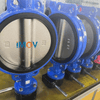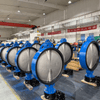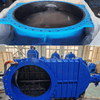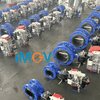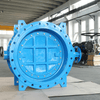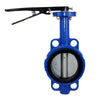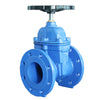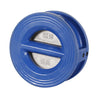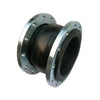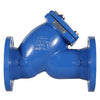What are the different types of valve end connections?
In practical engineering projects, valve selection depends not only on its control function but also—more importantly—on whether its connection type is compatible with the pipeline system. Different connection methods can significantly affect ease of installation, sealing reliability, structural integrity, and future maintenance.
The way a valve connects to the pipeline plays a critical role in system reliability, ease of installation, and long-term performance. Different connection types are designed to suit different operating conditions. This article provides a practical overview of the most common connection methods used in industrial valves, helping you choose the right one based on real application needs.
Flange connection
The valve has flanges at both ends, which are tightly connected with the paired flanges at the end of the pipeline through bolts, and gaskets are placed between the flanges to realize sealing.
Features:
- One of the most widely used and reliable connection methods.
- Suitable for various sizes (from small to very large), various pressure levels (from low pressure to ultra-high pressure), various temperature ranges and media.
- Easy to install, dismantle and repair (valves can be replaced online).
Flange Standards:
There are various standards, and they must match those of the pipeline system. Common standards include:
- ANSI/ASME: American standards (Class 150, 300, 600, 900, 1500, 2500)
- EN / DIN: European/German standards
- EN 1092-1 (replaces most DIN standards)
- DIN 2573, 2576, 2633, 2634, 2635 (older standards)
- JIS: Japanese standards (5K, 10K, 16K, 20K, 30K)
- BS: British standards (PN series, similar to DIN)
Flange Face Types:
- RF (Raised Face): Most common type; a slightly raised, circular sealing surface on the flange face.
- FF (Flat Face): Entire flange face is flat, with no raised section.
- RTJ (Ring Type Joint): A groove is machined into the flange face to fit a metal ring gasket for high-pressure sealing.
- TG (Tongue and Groove): One side has a raised tongue, and the other has a matching groove.
- M&F (Male and Female Face): Similar to tongue and groove but generally deeper and wider.
- LJ (Lap Joint): The valve and pipe are not integrally formed; used with a lap joint flange for ease of alignment and rotation.
Advantages: high strength, reliable sealing, very wide range of applications, easy to install, disassemble and maintain, high degree of standardization.
Disadvantages: relatively high cost (flanges, bolts, gaskets), large volume and weight, requires a large installation space

Image Source:whatispiping
Threaded connection
Valve ends with internal or external threads are connected by screwing into the external threads on the pipe or the internal threads on the fittings.
Type.
- Male thread (Male): Threads on the outside of the connection, such as bolts, threaded pipe.
- Female thread (Female): Threads on the inside of the connection, such as nuts, threaded valve ports.
Common thread standards
- NPT: American tapered thread (sealing by thread deformation).
- BSPT: British tapered thread (sealing by thread deformation).
- BSPP: British straight thread (need to be sealed by a washer or O-ring)
Advantages: easy to install and disassemble, relatively low cost, suitable for small size (usually DN50 or less), medium and low pressure occasions.
Disadvantages: sealing reliability is relatively low (especially NPT / BSPT rely on thread deformation seal), not suitable for frequent disassembly, in the vibration or temperature change occasions easy to leak.

Welding connection
Type:
- Butt welding: the two pipes or components of the end face to face, through the fusion of the weld connection, welded to form a high strength, excellent sealing of the permanent connection.
- Socket Welding: Valve end is socket, pipe inserted into it, in the socket outside the corner of the fillet weld connection. Mainly used for small size (usually DN50 or less) high-pressure pipeline. Installation is faster than flanges and threads, and sealing is better than threads.
Advantages:
- High connection strength, good sealing performance
- Suitable for high temperature and pressure, corrosive environment
- Compact structure, space-saving
Disadvantages:
- Installation is not removable, maintenance is more complicated
- High welding quality requires professional operation
- Stress and corrosion problems may occur at the welding seam
Wafer Connection
A wafer connection is a compact design in which the valve is installed between two pipeline flanges without having flanges of its own. It’s held in place by the tightening force of flange bolts, with gaskets providing the necessary seal between surfaces.
Advantages:
- Saves installation space
- Lightweight and cost-effective
- Quick to install
- Compatible with various flange standards
Disadvantages:
- Disassembly requires complete removal of the flange bolts, not as convenient as flange connection maintenance;
- Sealing depends on bolt tightening force
- Not suitable for heavy or large diameter valves, limited structural strength andsupport.

Lug Connection
In a lug connection, the valve body features multiple threaded lugs (ears) around its perimeter. These allow the valve to be bolted independently to each of the adjacent flanges, providing a more secure and isolated connection.
Advantages:
- Allows one-sided pipeline disassembly without affecting the other side
- More robust than wafer-type: flange bolts are threaded directly into the valve body, distributing the load more evenly
- Suitable for dead-end service
- Flexible compatibility: lug hole patterns can be designed to match multiple standards such as ANSI or DIN
Disadvantages:
- Heavier and slightly more expensive than wafer-style valves
- Requires precise alignment between flange holes and lug holes during installation

Clamp (Tri-Clamp) Connection
Clamp connections use specially designed grooved or flanged valve ends, which are joined using a clamp—typically a two-piece assembly tightened by bolts. A gasket between the mating surfaces ensures sealing.
Advantages:
- Extremely fast to install and remove
- Easy to clean and inspect in-line; no dead zones (sanitary design)
- Allows for slight adjustments during installation
Disadvantages:
- Generally limited to low- and medium-pressure applications, especially in sanitary or hygienic systems.
- Requires matching pipe ends with flared lips or weld ferrules.
- The clamp itself can be a potential leakage point, though the gasket is seated in a defined groove.

Image Source:sanitaryfittings-cad
Conclusion
Each type of valve connection has its own advantages and limitations. Selecting the most appropriate connection method can not only improve system performance but also significantly reduce long-term maintenance costs. In real-world applications, a comprehensive assessment of factors such as operating conditions, available installation space, pressure class, and overall cost is essential to ensuring stable and efficient system operation over time, especially when valves are combined with other pipe fittings such as elbows, tees, reducers, and malleable iron pipe fittings.
Tianjin Union Valve is committed to providing a full range of high-performance valve products to customers worldwide, offering various connection types to meet the needs of both standard and demanding applications. With extensive engineering experience and strict quality control, Union Valve is your trusted partner. We offer not just products, but also professional technical support and customized solutions to help your project proceed smoothly and efficiently.If you have any other questions, please contact us.
Related Articles:
- How to read butterfly valve specifications for your needs
- Understanding P&ID Symbols for Valve Systems
- Selection of Butterfly Valve Materials in Different Media Environments
- Find Your Match: Butterfly Valve Handle Types Explained
- Do you know the 8 common API valve standards?
